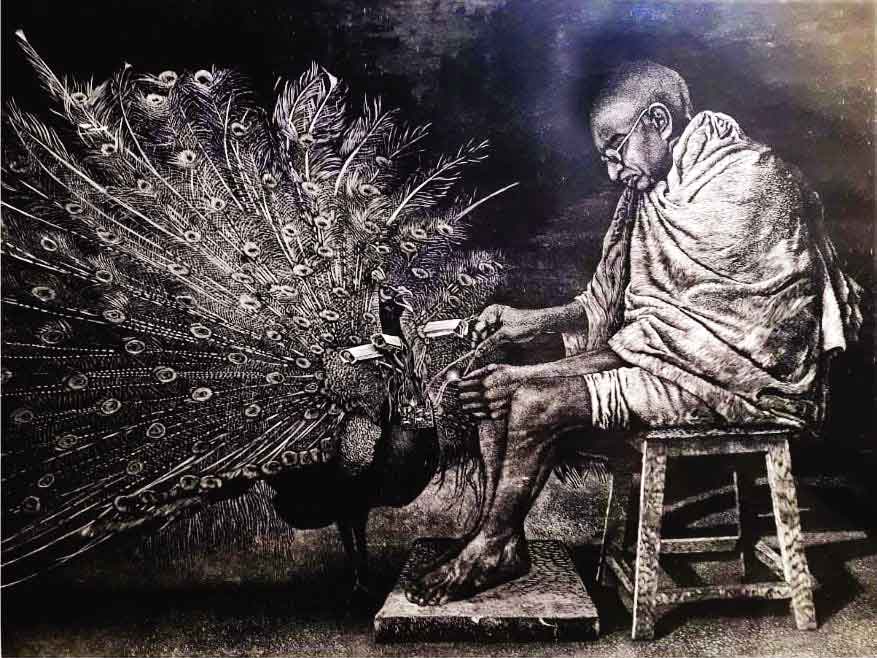The works of five printmakers at the Lalit Kala Akademi bring forth the success of the father of the nation in establishing mastery over self, says Uma Nair
Promising Mahatma Gandhi’s journey in ways that go beyond textbook literalism, Lalit Kala Akademi has brought together works by five printmakers to commemorate the national icon. It is intrinsic to use Mahatma Gandhi’s portrait to create conversations. The works create a context of metaphors, moulding with the iconic image of the ‘Father of the Nation’ in this commemoration of 150 years of Gandhi.
Behera’s Gandhi with wings
Baroda printmaker Subrat Behera creates a hand-coloured lithograph that excels in every way. He creates a Gandhi who walks across the skies and keeps a watch over a self-destructive world. Behera brings alive the words of the great anatomical artist and thinker Leonardo da Vinci when he said, ‘Painting is poetry that is seen rather than felt, and poetry is painting that is felt rather than seen.”
The printmaker’s Gandhi is a figure of strength with a pair of wings that remind us of an eagle. His eyes probe and penetrate into the layers of the world in the wake of the ugly mapping of terrorism. Three monkeys sit at the bottom, holding the scroll of realms that speak of truth, his experiments with it and ahimsa.
The artist’s entire choreography of the lithograph echoes with the philosophy of the Gandhian way of living, and his power and poignancy. One cannot forget that he gave a language of peace to the world through simple living and high thinking.
Hemvathy’s leaders
Hemvathy Guha creates a set of human figures with dotted details. A printmaker of rare esteem and devotion in her work at the Print Biennale in Delhi at the NGMA last year, stood out for its brilliance in conception, the controlled composition and the beauty of perfection in the contour of its woodcuts.
In these three prints, we think of the silence when a great leader departs and we bow our heads in reverence. Hemvathy asserts creative control, suggesting that her contribution is not just the design but the technique and technical finesse as she transfers the image to the rice paper or other sheets to create a universe that is indeed both intricate and deeply intriguing. The rendering of the people, their heads and their deftly-contoured bodies, all conform to the brilliance of not just execution but also of a fine and deeper understanding of the human figure.
Apte’s zinc plate
Dattaraye Apte is more than a mere printmaker. Over the years, he has a prodigious output in printmaking techniques and is indeed one of the finest. Apte creates his Mahatma on a zinc plate. We can see a glimpse of Gandhi, shown as a figure who is walking away from us. It sets a nostalgia-filled tone of how Bapu gathered strength from distress and grew brave by reflection of himself. Apte creates the father of the nation as a humanist as well as a colossus.
Anandmoyi’s two views
Anandamoyi presents two works that look at an artist’s role as an active commentator and how it inspires to create works that look closely at the structures of the society and the individual. He calls his first work, Who is he?, whereas, the second one is called It’s now or never, which recalls the popular Elvis Song but the mood is far from romantic.
His major conceptual direction has been about caste and colour in our society and Gandhi was an important link. “The Dandi March, regardless of anything or everything, was directed towards as if it’s now or never,” says Anandamoyi and adds, “The man in black and white is a question for men of colour in society, these were and still are probably important issues for our society to address.” Anandamoyi uses drawings over and over again to create new forms linking them to relationships in society. He finds relations between layers in his prints as well as in time and space in society.
Tammineni’s Birth of a Nation
Jagdeesh Tammineni began his Birth of a Nation series in 2013 and his penchant for asking questions is what surfaces as an embodiment of principles in reason and rationality in the domain of human understanding. His Gandhi with the cow and the peacock are both seminal works that reflect a deeper understanding of the ideas of Gandhi that seem to have eroded somewhere along the way.
Jagdeesh’s sense of judgment in the composition of his two woodcuts is precise and full of expressionist excellence. We must look at both these works at a glance and muse over the lack of harmony and proportion in society’s fabric which we rarely think about when we dwell on divisions within divisions and economic struggles.
All these five printmakers bring forth the epoch of a man whose success is gauged by his self-mastery. And this law is the expression of eternal justice. He who cannot establish dominion over himself will have no dominion over others. In more ways than one they also mirror Gandhi’s reflection: Seek not greater wealth, but simpler pleasure; not higher fortune, but deeper felicity.
(The exhibition will be on display at the Lalit Kala Akademi from October 2 to 22.)


























